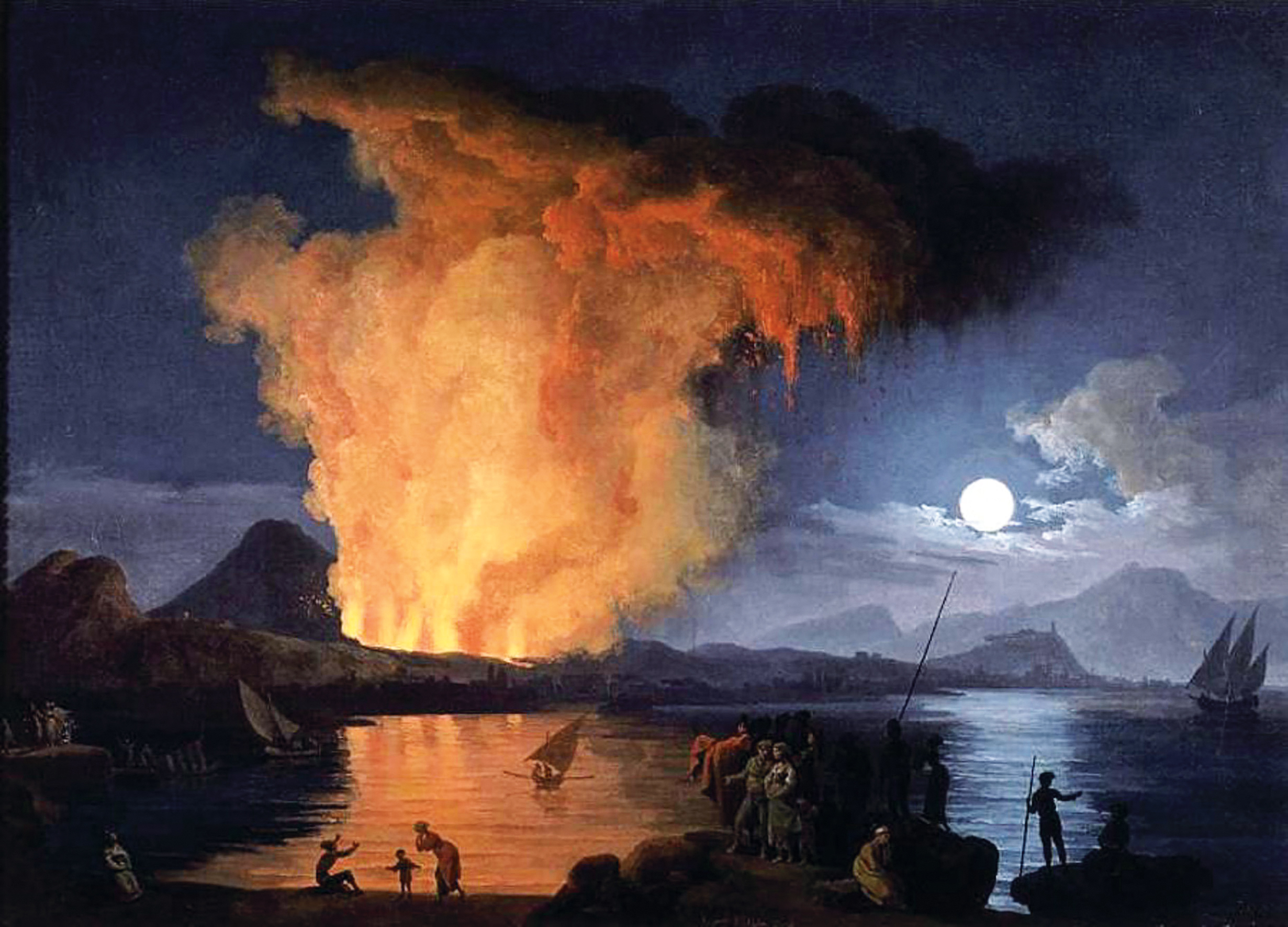
Mount Vesuvius had a busy 18th century, with some six major eruptions and near continuous growlings and spurtings. This restlessness and the immanence of danger it signified made the volcano an object of fascination to the European mind. With the Enlightenment, it also became a symbol of two different attitudes: for those with a religious cast, Vesuvius was an example of divine power and possible retribution, with the potential to unleash a catastrophe analogous to the biblical flood; while for the new thinkers it was both an emblem of nature’s potency and an opportunity for scientific inquiry.
Vesuvius offered something too that lay outside philosophical realms – the visceral thrill of pyrotechnical displays of fire and lava. The mountain gave a son et lumière spectacle of unparalleled, awe-inspiring grandeur that put humans in their place. If it invoked in visiting onlookers an enjoyable shiver, then it lurked ever-present in the lives of the inhabitants of the Bay of Naples. As Goethe wrote in 1817: “Surely the Neapolitan would be a different human being if he did not feel himself wedged between God and Satan.” And as if the locals needed reminding, the obliterating force of the eruption of 79 AD was given haunting reinforcement by the discovery of the ruins of Herculaneum in 1709 and Pompeii in 1748.
For artists, the volcano had an extra significance: it embodied Edmund Burke and Immanuel Kant’s theories of the sublime, which defined terror, vastness and limitless power as working on the emotions and imagination to produce an amalgam of fear and attraction. It was an aesthetic that lay at the heart of burgeoning Romanticism. Among the British painters who took Vesuvius for a subject were Joseph Wright of Derby (who didn’t see an eruption on his one visit but nevertheless painted some 30 pictures of it), Turner and John Martin, while any number of minor painters turned out eruption pictures for souvenir-hunting Grand Tourists.
One artist, however, made Vesuvius his own: Pierre-Jacques Volaire (1729-99), also called the Chevalier Volaire and sometimes, thanks to his volcano nocturnes, the Chevalier Noir. In 1768-69 Volaire installed himself in Naples and spent the next 30 years producing pictures of the mountain and its environs. It was he who more than anyone established Vesuvius pictures as a recognisable genre and gained fame as a result: “No painter ever excelled Volaire in water, fire and moonlight scenes,” wrote the English traveller and collector Henry Blundell, name-checking the elements that made the painter so popular and that are encapsulated in this picture from the 1770s, now in a private collection.
Naples was not such a strange place for Volaire to end up. He had been born into a family of painters, decorators and cartographers in Toulon, another Mediterranean port city, and trained in the family workshop. He came of age artistically, however, in 1755, as assistant to the celebrated French landscapist Claude-Joseph Vernet, who had been commissioned by King Louis XV to paint a series of pictures showing the ports of France (15 were eventually completed). For the next eight years Volaire toured the country with Vernet – who had a similar family background to Volaire – making drawings for pictures of Bordeaux, Dieppe, La Rochelle and the rest.
[see also: Atkinson Grimshaw’s glistening landscapes of Victorian prosperity]
Vernet was also noted for his shipwreck scenes, and emulating them gave the younger man a grounding in melodrama, light effects, composition and the idea of the “historical landscape” as derived from Claude Lorrain. In 1763, Volaire further emulated his master by going to Rome to study classical and Renaissance art, and forge an independent career. The following year he was admitted to the painters’ guild, the Académie de Saint-Luc; it was as a cavaliere of the guild that he earned his dashing honorific.
His Rome paintings showed his debt to Vernet – ports, shipwrecks, night fires – and although many of the scenes were imaginary they were nevertheless based on the methods of scrupulous observation and drawing he had learned with Vernet. When he settled in Naples these same traits endeared him to the budding vulcanologists who studied Vesuvius.
There Volaire witnessed most of the major volcanic events of the second half of the century, and his paintings accurately demonstrated his first-hand knowledge. While some showed dramatic end-of-times scenes of crowds fleeing in panic as Vesuvius erupts, others depicted curious onlookers and men of science carefully and precariously observing the lava flows and spitting flames while standing on the very edge of fissures. The artist himself was keen to show that his scenes were not fanciful, on one occasion by inscribing a painting: “View of the eruption of Mount Vesuvius on 14 May 1771 painted on-site by the Chevalier Volaire.”
It was this scrupulous realism matched with a sense of pictorial decorum that endeared him to his mostly foreign clients. Among those keen to have a slice of untrammelled nature from his hand were Catherine the Great and Ferdinand IV, king of Naples. Another collector was Sir William Hamilton, British envoy to the court of Naples. While Hamilton’s wife Emma described Vesuvius as simply “monstrous”, the diplomat was a noted vulcanologist who climbed the volcano 22 times in his first four years in Naples, sent rock samples back to the Royal Society in London, constructed an exploding model Vesuvius, and would go on to publish two books on volcanoes.
Volaire might have been repetitious but it is not hard to see why he was in demand. His paintings mirrored his times and straddled the divide between scientific exactitude and the nature mysticism that was then stirring; they offer drama and wildness with artistic appropriateness while warding off sedateness; and the thrill they offer is vicarious but vivid. If it wasn’t fully fear he painted, then Volaire was the master of frisson.
[see also: The fabric of nature]
This article appears in the 20 Jan 2021 issue of the New Statesman, Biden's Burden





